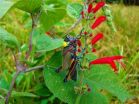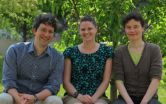(Press-News.org) WINSTON-SALEM, N.C. – May 8, 2014 – An old idea of retreating lung tumors with radiation is new again, especially with the technological advances seen in radiation oncology over the last decade.
The Comprehensive Cancer Center of Wake Forest Baptist Medical Center is one of only a handful of cancer centers that is attempting to give lung cancer patients out of treatment options a chance to keep the cancer at bay. For these patients, hope lies in a second course of treatment – repeat radiation. Two complementary papers published back-to-back recently in the journal Radiotherapy and Oncology and the Journal of Thoracic Oncology outline the treatment success at Wake Forest Baptist.
"One of the toughest challenges of lung cancer is what to do for patients when the cancer comes back in an area that's been treated previously with radiation treatment," said James J. Urbanic, M.D., lead author of the studies and a radiation oncologist at Wake Forest Baptist. "With some of the technological advances in radiation treatments that have occurred in the last five to 10 years, we're beginning to re-look at the issue and ask – can we target the radiation precisely enough and with a high enough dose to knock the cancer back?"
Urbanic said the overall findings of the study suggest that there are some patients with recurrent lung cancers who can be treated with another definitive course of radiation therapy and still have a chance at a cure. "At many cancer treatment centers, these patients only get chemotherapy and have no chance at definitive treatment. The goal of treatment is solely to prevent or delay symptoms from developing and they are seen as incurable," he said. "But with re-irradiation, our study shows that maybe we can give a curative intent treatment that we couldn't do in the past. It's a layer of hope for some patients that they never had before."
For this study, the researchers looked back at 11 years of clinical data. Eighty-six patients were identified who received at least two courses of thoracic radiotherapy. Of that number, 33 were treated with repeat thoracic radiotherapy using stereotactic body radiation therapy (SBRT) or accelerated hypofractionated radiotherapy (AHRT), as a component of their treatment. The median age was 66 and the majority of patients (88 percent) were treated for primary lung cancer. Average tumor size at retreatment was 2.5 cm. Prior lung resections had been completed in 24 percent of patients.
Urbanic said the typical patient is an older man or woman who got treated with either chemotherapy and radiation or radiation alone for a lung cancer that couldn't be surgically removed. They've returned for a checkup and feel well, but a CT scan shows that the cancer has returned in the area previously treated. If the cancer is just in one spot, the patients get retreated with 10 radiation treatments done with the SBRT technique which is tightly targeted to just the tumor and minimizes the dose to the surrounding normal tissue.
"Wake Forest Baptist has been developing expertise in doing this," Urbanic said. "We're finding that there are patients who are alive years later. We have seen relatively modest toxicity and a good ability to try and control the disease – upwards of 70 percent of the time."
But there is a higher risk of injury involved when someone is radiated a second time which is why other cancer treatment center programs might be reluctant to adopt the practice, he said.
"This is a fairly niche effort in lung cancer care, and we'd like to see a national level clinical trial at some point," he said. "The technology has gotten to the point where I think it's going to allow radiation oncologists to reassess their ability so that maybe they can take risks they weren't willing to take before. Eventually, this practice will become more widespread."
INFORMATION:
Co-authors include Jeremy M. Kilburn, M.D., Jeffrey G. Kuremsky, M.D., A. William Blackstock, M.D., Michael T. Munley, Ph.D., William T. Kearns, M.S., William H. Hinson, Ph.D., James F. Lovato, M.S., Antonius A. Miller, M.D., and William J. Petty, M.D., all of Wake Forest Baptist.
Wake Forest Baptist finds success with novel lung cancer treatment
Advances in technology make procedure possible
2014-05-08
ELSE PRESS RELEASES FROM THIS DATE:
Health screening for low-income women under health care reform: Better or worse?
2014-05-08
New Rochelle, NY, May 8, 2014—When Massachusetts enacted its own statewide health insurance reform in 2006, low-income women transitioned from receiving free, federally subsidized screening for breast and cervical cancer and cardiovascular disease risk to an insurance-based payment system. The effects on screening rates in this vulnerable population are explored in Journal of Women's Health, a peer-reviewed publication from Mary Ann Liebert, Inc., publishers. The article is available free on the Journal of Women's Health website at http://online.liebertpub.com/doi/full/10.1089/jwh.2013.4612.
A ...
This FIB doesn't lie: New NIST microscope sees what others can't
2014-05-08
Microscopes don't exactly lie, but their limitations affect the truths they can tell. For example, scanning electron microscopes (SEMs) simply can't see materials that don't conduct electricity very well, and their high energies can actually damage some types of samples.
In an effort to extract a little more truth from the world of nanomaterials and nanostructures, researchers at the National Institute of Standards and Technology (NIST) have built the first low-energy focused ion beam (FIB) microscope that uses a lithium ion source.*
The team's new approach opens up ...
Oregon researchers capture handoff of tracked object between brain hemispheres
2014-05-08
EUGENE, Ore. -- When tracking a moving object, the two halves of the human brain operate much like runners successfully passing a baton during a relay race, says a University of Oregon researcher.
In a study online ahead of print in Current Biology, electroencephalogram (EEG) measured brainwaves from healthy young adults revealed how information about an attended object -- one being watched closely -- moves from one brain hemisphere to the other.
Such handoffs are necessary because the human visual system is contralateral; objects on the left side of space are processed ...
New grasshopper species named after Grammy winner
2014-05-08
A newly discovered grasshopper by University of Central Florida scientists now bears the name of Grammy-award winning singer and activist Ana Lila Downs Sanchez.
The scientists named the new species discovered on the side of a mountain road near Oaxaca, Mexico, after the Mexican-American singer as a nod to her efforts to preserve indigenous culture and penchant for wearing colorful, local costumes as part of her performances.
"It was primarily Paolo's idea to name the grasshopper after the singer" said Derek Woller, one of the authors of the paper referring to colleague ...
Obesity drug failing patients due to lack of education about side-effects
2014-05-08
A new study, published today in the Journal of Health Psychology, found that patients who gained weight 18 months after taking Orlistat attributed their weight-loss failure either to the side effects which have prevented them from sticking to the medication or felt that the medication simply had not worked.
The team from the University of Surrey also found that participants described a series of barriers to weight loss including psychological and physical health issues, relationships and the make-up of their bodies. They also described a number of alternative methods ...
Urine test best detects alcohol use in liver transplant candidates, recipients
2014-05-08
Researchers from Italy confirm that urinary ethyl glucuronide (uEtG) accurately detects alcohol consumption in liver transplant candidates and recipients. The study published in Liver Transplantation, a journal of the American Association for the Study of Liver Diseases and the International Liver Transplantation Society, suggests that a combination of uEtG and the Alcohol Use Disorders Identification Test for alcohol consumption (AUDIT-c) are best in alerting doctors to alcohol consumption by patients undergoing evaluation for liver transplantation or who have received ...
Breakthrough made at Max F. Perutz Laboratories
2014-05-08
Researchers at the Max F. Perutz Laboratories (MFPL) of the University of Vienna and the Medical University of Vienna made a breakthrough for the Platynereis model system, as they describe the first method for generating specific and inheritable mutations in the species. The method, in combination with other tools, now places this marine bristle worm in an excellent position to advance research at the frontiers of neurobiology, chronobiology, evolutionary developmental biology and marine biology. The study and a review on Platynereis dumerilii genetic methods were chosen ...
Fungus may help stop invasive spread of tree-of-heaven
2014-05-08
A naturally occurring fungus might help curb the spread of an invasive tree species that is threatening forests in most of the United States, according to researchers.
Researchers tested the fungus -- Verticillium nonalfalfae -- by injecting it into tree-of-heaven, or Ailanthus, plots, according to Matthew Kasson, who recently received his doctorate in plant pathology and environmental microbiology from Penn State. The treatment completely eradicated the tree-of-heaven plants in those forests.
"It appears that this treatment is effective in Pennsylvania and could ...
New paper provides important insights into carcinoma-associated fibroblasts
2014-05-08
A new paper by a team of researchers led by Zachary T. Schafer, Coleman Assistant Professor of Cancer Biology in the Department of Biological Sciences at the University of Notre Dame, offers important new insights into the role carcinoma-associated fibroblasts (CAFs) play in tumor biology. A number of recent studies have revealed CAFs to be a major contributor to tumor progression through a variety of mechanisms. Despite this information, the precise role CAFs play in augmenting the growth of tumors is still poorly understood.
In their new paper, Schafer and his fellow ...
'Teenage' songbirds experience high mortality due to many causes, MU study finds
2014-05-08
Nearly one-third of songbird species across North America are experiencing long-term declines. Scientists have spent years researching potential causes for these population declines, focusing on the birds when they have just hatched as well as when they are adults. Now, researchers from the University of Missouri and the U.S. Department of Agriculture have found that songbirds are vulnerable to environmental dangers particularly when they are juveniles, shortly after they have left their parents' nests. Frank Thompson, a scientist with the USDA Forest Service and an associate ...
LAST 30 PRESS RELEASES:
Low daily alcohol intake linked to 50% heightened mouth cancer risk in India
American Meteorological Society announces Rick Spinrad as 2026 President-Elect
Biomass-based carbon capture spotlighted in newly released global climate webinar recording
Illuminating invisible nano pollutants: advanced bioimaging tracks the full journey of emerging nanoscale contaminants in living systems
How does age affect recovery from spinal cord injury?
Novel AI tool offers prognosis for patients with head and neck cancer
Fathers’ microplastic exposure tied to their children’s metabolic problems
Research validates laboratory model for studying high-grade serous ovarian cancer
SIR 2026 delivers transformative breakthroughs in minimally invasive medicine to improve patient care
Stem Cell Reports most downloaded papers of 2025 highlight the breadth and impact of stem cell research
Oxford-led study estimates NHS spends around 3% of its primary and secondary care budget on the health impacts of heat and cold in England
A researcher’s long quest leads to a smart composite breakthrough
Urban wild bees act as “microbial sensors” of city health.
New study finds where you live affects recovery after a hip fracture
Forecasting the impact of fully automated vehicle adoption on US road traffic injuries
Alcohol-related hospitalizations from 2016 to 2022
Semaglutide and hospitalizations in patients with obesity and established cardiovascular disease
Researchers ‘listen in’ to embryo-mother interactions during implantation using a culture system replicating the womb lining
How changing your diet could help save the world
How to make AI truly scalable and reliable for real-time traffic assignment?
Beyond fragmented markets: A new framework for efficient and stable ride-pooling
Can shape priors make road perception more reliable for autonomous driving?
AI tracks nearly 100 years of aging research, revealing key trends and gaps
Innovative techniques enable Italy’s first imaging of individual trapped atoms
KIER successfully develops Korea-made “calibration thermoelectric module” for measuring thermoelectric device performance
Diversifying US Midwest farming for stability and resilience
Emphasizing immigrants’ deservingness shifts attitudes
Japanese eels, climate change, and river temperature
Pusan National University researchers discover faster, smarter heat treatment for lightweight magnesium metals
China’s 2024 Gastroenterology Report: marked progress in endoscopy quality and disease management
[Press-News.org] Wake Forest Baptist finds success with novel lung cancer treatmentAdvances in technology make procedure possible





